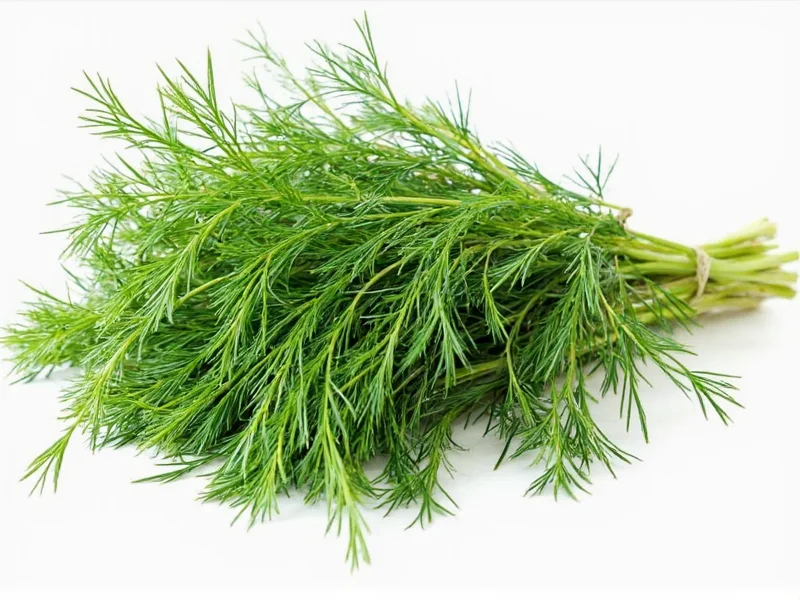Understanding the relationship between dill seed and dill weed is essential for successful recipe adaptation. Both come from the same plant (Anethum graveolens), but they represent different parts with distinct flavor profiles and culinary applications. This comprehensive guide explains exactly how to substitute dill seed for dill weed while maintaining your dish's intended flavor balance.
Understanding Dill Seed vs. Dill Weed
Dill weed refers to the feathery green leaves of the dill plant, available fresh or dried. It offers a delicate, grassy flavor with subtle anise notes that works well in fresh applications. Dill seed, meanwhile, comes from the plant's mature fruit and delivers a stronger, more pungent taste with citrus and caraway undertones.
The fundamental difference lies in their chemical composition. Dill weed contains higher concentrations of monoterpenes that provide its fresh, herbal character, while dill seed has more flavonoids and higher oil content that create its robust, earthy profile. This explains why direct 1:1 substitution often results in overpowering flavors.
When Substitution Works Best
Successful substitution depends on your recipe type. Consider these practical guidelines for using dill seed instead of dill weed:
- Cooked dishes: Works well in pickling recipes, soups, stews, and breads where heat mellowes the seed's intensity
- Marinades and sauces: Effective when seeds are crushed or toasted first to release flavors
- Dry rubs: Provides excellent flavor penetration for meats and vegetables
Substitution works poorly in fresh applications like salads, dips, or as a garnish where dill weed's delicate flavor would be overwhelmed by the seed's potency.
Accurate Substitution Ratios
Precise measurement conversion is critical when replacing dill weed with dill seed. The following table provides exact ratios for different recipe contexts:
| Recipe Type | Dill Weed Required | Dill Seed Substitute | Additional Tips |
|---|---|---|---|
| Pickling recipes | 1 tablespoon | 1½ teaspoons | Add seeds to brine at beginning of process |
| Soups & stews | 1 tablespoon | 1 teaspoon | Add early to allow flavors to mellow |
| Breads & baked goods | 1 tablespoon | ¾ teaspoon | Toast seeds first for enhanced flavor |
| Fresh salads & dips | 1 tablespoon | ¼ teaspoon (crushed) | Use only as last resort; flavor won't match |
Alternative Substitutes When Dill Seed Isn't Ideal
If your recipe specifically requires dill weed's delicate flavor, consider these alternatives when you don't have dill weed available:
- Fennel fronds: Provides similar anise notes (use 1:1 ratio)
- Tarragon: Offers comparable herbal complexity (use ¾ amount)
- Parsley with a pinch of anise seed: Creates approximation of dill flavor
- Dill pollen: Intensely flavorful alternative (use ¼ amount)
For those exploring substituting dill weed for dill seed, reverse the ratios: use 3 tablespoons of dill weed to replace 1 teaspoon of dill seed. This works best in dishes where you want a milder dill presence.
Practical Cooking Tips
Maximize your substitution success with these professional techniques:
- Crush dill seeds in a mortar and pestle before using to release more flavor
- Toast seeds in a dry pan for 1-2 minutes to enhance their aromatic qualities
- Add dill seed early in cooking processes to allow harsh notes to mellow
- Store both forms properly - seeds in airtight containers away from light, weed in freezer for maximum freshness
- Consider regional variations - European dill seed tends to be more potent than American varieties
When adapting recipes that call for dill weed but you only have dill seed, remember that the substitution works best in heartier dishes where the stronger flavor can integrate well. For delicate fish dishes or creamy sauces, consider using one of the alternative substitutes mentioned above for better flavor balance.
Common Questions About Dill Substitutions
Can I use dill seed instead of dill weed in tzatziki sauce?
It's not recommended. Tzatziki requires the delicate flavor of dill weed, and dill seed would overpower the sauce with its stronger, more pungent taste. If you must substitute, use only ¼ teaspoon of crushed dill seed per cup of yogurt and consider adding a pinch of fresh parsley to balance the flavor.
How does substituting dill seed affect pickling recipes?
Dill seed actually works better than dill weed in pickling recipes because its stronger flavor holds up well during the preservation process. Use 1½ teaspoons of dill seed per quart instead of 1 tablespoon of dill weed, and add it directly to the jar before pouring in the brine for optimal flavor distribution.
What's the best way to substitute dill seed in potato salad?
For potato salad, use ½ teaspoon of dill seed (lightly crushed) to replace 1½ tablespoons of dill weed. Toast the seeds first to mellow their intensity, then mix with the dressing ingredients before combining with potatoes. This creates a more integrated flavor than adding whole seeds directly to the salad.
Does the substitution ratio change for dried versus fresh dill weed?
Yes. When substituting dill seed for fresh dill weed, use 1 teaspoon dill seed per 1 tablespoon fresh. For dried dill weed, use 1 teaspoon dill seed per 2 teaspoons dried dill weed, as dried weed is already more concentrated than fresh. Always remember that dill seed is significantly more potent than either form of dill weed.
Can I make my own dill weed substitute using dill seed?
You can create a closer approximation by combining ¼ teaspoon crushed dill seed with 2 teaspoons fresh parsley and a tiny pinch of fennel pollen or anise seed. This mixture mimics dill weed's flavor profile better than dill seed alone, though it won't be identical. Use this blend in a 1:1 ratio to replace fresh dill weed in most recipes.











 浙公网安备
33010002000092号
浙公网安备
33010002000092号 浙B2-20120091-4
浙B2-20120091-4